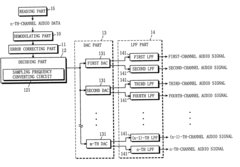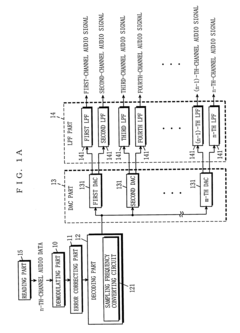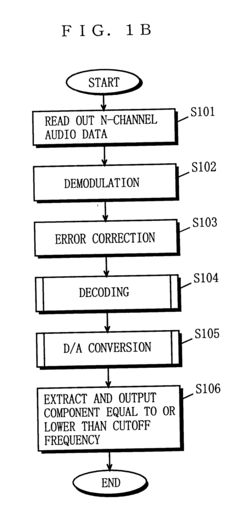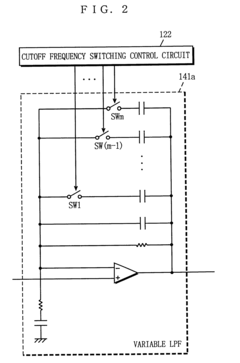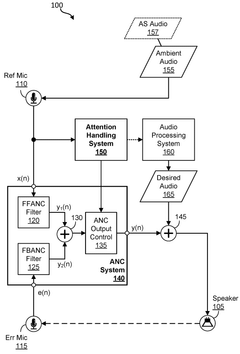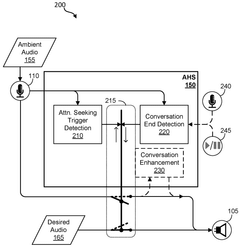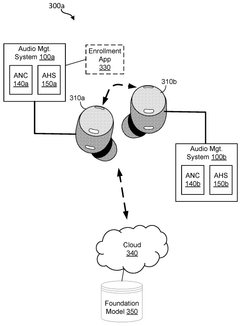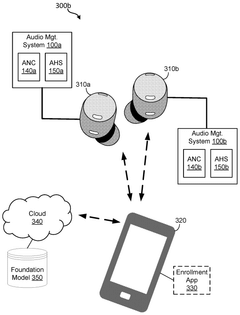How LDAC Contributes to a Seamless Listening Experience?
JUL 4, 20258 MIN READ
Generate Your Research Report Instantly with AI Agent
Patsnap Eureka helps you evaluate technical feasibility & market potential.
LDAC Technology Overview
LDAC (Low Latency Audio Codec) is a cutting-edge audio coding technology developed by Sony Corporation, designed to deliver high-resolution audio over Bluetooth connections. This proprietary codec aims to address the limitations of traditional Bluetooth audio transmission, which often results in compromised sound quality due to bandwidth constraints.
At its core, LDAC employs advanced compression algorithms that allow for the transmission of audio data at up to 990 kbps, significantly higher than the standard SBC (Sub-band Coding) codec used in most Bluetooth devices. This increased data rate enables LDAC to preserve more of the original audio information, resulting in a listening experience that closely resembles wired high-fidelity audio systems.
LDAC operates on three distinct bitrate modes: 330 kbps, 660 kbps, and 990 kbps. These modes are dynamically selected based on the wireless environment and device capabilities, ensuring optimal performance across various scenarios. The adaptive nature of LDAC contributes to its robustness in real-world conditions, where signal interference and distance can affect Bluetooth transmission quality.
One of the key features of LDAC is its support for 24-bit/96 kHz audio formats, which is considered high-resolution audio. This capability allows for the reproduction of a wider frequency range and greater dynamic range compared to standard CD-quality audio (16-bit/44.1 kHz). As a result, listeners can experience more detailed and nuanced sound, with improved clarity and spatial imaging.
LDAC achieves its high-quality audio transmission through several technical innovations. It utilizes a hybrid coding scheme that combines lossless and lossy compression techniques, optimizing the balance between audio quality and data efficiency. Additionally, LDAC employs sophisticated error correction and concealment methods to maintain audio integrity even in challenging wireless environments.
The codec's low latency characteristics are particularly beneficial for applications requiring precise audio-video synchronization, such as gaming and video playback. By minimizing the delay between audio processing and playback, LDAC helps to create a more immersive and responsive user experience across various multimedia applications.
As part of the Bluetooth audio ecosystem, LDAC is compatible with a wide range of devices, including smartphones, tablets, portable audio players, and wireless headphones. However, both the transmitting and receiving devices must support LDAC to take advantage of its benefits, which has led to increased adoption by various manufacturers beyond Sony.
At its core, LDAC employs advanced compression algorithms that allow for the transmission of audio data at up to 990 kbps, significantly higher than the standard SBC (Sub-band Coding) codec used in most Bluetooth devices. This increased data rate enables LDAC to preserve more of the original audio information, resulting in a listening experience that closely resembles wired high-fidelity audio systems.
LDAC operates on three distinct bitrate modes: 330 kbps, 660 kbps, and 990 kbps. These modes are dynamically selected based on the wireless environment and device capabilities, ensuring optimal performance across various scenarios. The adaptive nature of LDAC contributes to its robustness in real-world conditions, where signal interference and distance can affect Bluetooth transmission quality.
One of the key features of LDAC is its support for 24-bit/96 kHz audio formats, which is considered high-resolution audio. This capability allows for the reproduction of a wider frequency range and greater dynamic range compared to standard CD-quality audio (16-bit/44.1 kHz). As a result, listeners can experience more detailed and nuanced sound, with improved clarity and spatial imaging.
LDAC achieves its high-quality audio transmission through several technical innovations. It utilizes a hybrid coding scheme that combines lossless and lossy compression techniques, optimizing the balance between audio quality and data efficiency. Additionally, LDAC employs sophisticated error correction and concealment methods to maintain audio integrity even in challenging wireless environments.
The codec's low latency characteristics are particularly beneficial for applications requiring precise audio-video synchronization, such as gaming and video playback. By minimizing the delay between audio processing and playback, LDAC helps to create a more immersive and responsive user experience across various multimedia applications.
As part of the Bluetooth audio ecosystem, LDAC is compatible with a wide range of devices, including smartphones, tablets, portable audio players, and wireless headphones. However, both the transmitting and receiving devices must support LDAC to take advantage of its benefits, which has led to increased adoption by various manufacturers beyond Sony.
Audio Market Trends
The audio market has been experiencing significant growth and transformation in recent years, driven by technological advancements and changing consumer preferences. The global audio market size was valued at $20.31 billion in 2020 and is projected to reach $31.83 billion by 2028, growing at a CAGR of 5.8% during the forecast period. This growth is primarily attributed to the increasing demand for wireless audio devices, smart speakers, and high-quality audio experiences.
One of the most notable trends in the audio market is the shift towards wireless audio solutions. The popularity of Bluetooth-enabled devices, particularly true wireless stereo (TWS) earbuds, has skyrocketed. In 2020, the TWS market saw a 78% year-over-year growth, with over 233 million units shipped globally. This trend is expected to continue, with the TWS market projected to reach 500 million units by 2023.
Another significant trend is the growing demand for high-resolution audio. Consumers are increasingly seeking premium audio experiences, driving the adoption of advanced audio codecs like LDAC. The high-resolution audio market is expected to grow at a CAGR of 19.2% from 2021 to 2028, reflecting the increasing consumer appetite for superior sound quality.
Smart speakers have also emerged as a major force in the audio market. The global smart speaker market size was valued at $4.4 billion in 2020 and is expected to grow at a CAGR of 21.3% from 2021 to 2028. This growth is fueled by the integration of voice assistants and smart home functionalities, making these devices central to the connected home ecosystem.
The automotive audio market is another area experiencing significant growth. With the rise of electric vehicles and autonomous driving technologies, in-car audio systems are becoming increasingly sophisticated. The global automotive audio market is projected to reach $7.5 billion by 2026, growing at a CAGR of 6.7% from 2021 to 2026.
Spatial audio technologies are gaining traction, offering immersive 3D sound experiences. This trend is particularly evident in the gaming and virtual reality sectors, where spatial audio enhances user engagement and realism. The spatial audio market is expected to grow at a CAGR of 17.2% from 2021 to 2026.
As consumers become more environmentally conscious, there is a growing demand for sustainable audio products. Manufacturers are responding by using recycled materials, implementing eco-friendly packaging, and designing products with longer lifespans. This trend is likely to shape product development and marketing strategies in the coming years.
One of the most notable trends in the audio market is the shift towards wireless audio solutions. The popularity of Bluetooth-enabled devices, particularly true wireless stereo (TWS) earbuds, has skyrocketed. In 2020, the TWS market saw a 78% year-over-year growth, with over 233 million units shipped globally. This trend is expected to continue, with the TWS market projected to reach 500 million units by 2023.
Another significant trend is the growing demand for high-resolution audio. Consumers are increasingly seeking premium audio experiences, driving the adoption of advanced audio codecs like LDAC. The high-resolution audio market is expected to grow at a CAGR of 19.2% from 2021 to 2028, reflecting the increasing consumer appetite for superior sound quality.
Smart speakers have also emerged as a major force in the audio market. The global smart speaker market size was valued at $4.4 billion in 2020 and is expected to grow at a CAGR of 21.3% from 2021 to 2028. This growth is fueled by the integration of voice assistants and smart home functionalities, making these devices central to the connected home ecosystem.
The automotive audio market is another area experiencing significant growth. With the rise of electric vehicles and autonomous driving technologies, in-car audio systems are becoming increasingly sophisticated. The global automotive audio market is projected to reach $7.5 billion by 2026, growing at a CAGR of 6.7% from 2021 to 2026.
Spatial audio technologies are gaining traction, offering immersive 3D sound experiences. This trend is particularly evident in the gaming and virtual reality sectors, where spatial audio enhances user engagement and realism. The spatial audio market is expected to grow at a CAGR of 17.2% from 2021 to 2026.
As consumers become more environmentally conscious, there is a growing demand for sustainable audio products. Manufacturers are responding by using recycled materials, implementing eco-friendly packaging, and designing products with longer lifespans. This trend is likely to shape product development and marketing strategies in the coming years.
LDAC Technical Challenges
LDAC, while offering significant advancements in wireless audio transmission, faces several technical challenges that impact its seamless listening experience. One of the primary hurdles is the high bandwidth requirement for transmitting high-resolution audio. LDAC operates at bitrates up to 990 kbps, which can strain the capabilities of many Bluetooth connections, especially in environments with high interference or when the device is at the edge of its range.
Another challenge lies in maintaining consistent audio quality across varying signal strengths. As users move around or encounter obstacles, the Bluetooth signal can fluctuate, potentially causing dropouts or quality degradation. LDAC's adaptive bitrate feature attempts to mitigate this, but achieving a truly seamless transition between different bitrates without noticeable audio artifacts remains a complex task.
Power consumption is a significant concern, particularly for portable devices. The high data throughput of LDAC requires more processing power and energy, which can lead to reduced battery life in both the transmitting and receiving devices. Balancing high-quality audio with energy efficiency is an ongoing challenge for LDAC implementation.
Latency is another critical issue, especially in scenarios requiring precise audio-video synchronization, such as gaming or video playback. While LDAC offers lower latency compared to some other codecs, achieving imperceptible delay across all use cases remains a technical hurdle.
Compatibility and interoperability present additional challenges. Not all devices support LDAC, and ensuring seamless integration with a wide range of hardware and software configurations can be complex. This includes managing the handshake process between devices and gracefully falling back to alternative codecs when necessary.
The complexity of the LDAC encoding and decoding processes also poses challenges in terms of implementation. Efficient algorithms and optimized hardware are required to handle the high-bitrate audio streams in real-time, which can be particularly demanding for smaller or less powerful devices.
Lastly, maintaining audio quality consistency across different source materials and playback environments is an ongoing challenge. LDAC must adapt to various audio formats, sampling rates, and bit depths while preserving the original audio fidelity as much as possible, all within the constraints of wireless transmission.
Another challenge lies in maintaining consistent audio quality across varying signal strengths. As users move around or encounter obstacles, the Bluetooth signal can fluctuate, potentially causing dropouts or quality degradation. LDAC's adaptive bitrate feature attempts to mitigate this, but achieving a truly seamless transition between different bitrates without noticeable audio artifacts remains a complex task.
Power consumption is a significant concern, particularly for portable devices. The high data throughput of LDAC requires more processing power and energy, which can lead to reduced battery life in both the transmitting and receiving devices. Balancing high-quality audio with energy efficiency is an ongoing challenge for LDAC implementation.
Latency is another critical issue, especially in scenarios requiring precise audio-video synchronization, such as gaming or video playback. While LDAC offers lower latency compared to some other codecs, achieving imperceptible delay across all use cases remains a technical hurdle.
Compatibility and interoperability present additional challenges. Not all devices support LDAC, and ensuring seamless integration with a wide range of hardware and software configurations can be complex. This includes managing the handshake process between devices and gracefully falling back to alternative codecs when necessary.
The complexity of the LDAC encoding and decoding processes also poses challenges in terms of implementation. Efficient algorithms and optimized hardware are required to handle the high-bitrate audio streams in real-time, which can be particularly demanding for smaller or less powerful devices.
Lastly, maintaining audio quality consistency across different source materials and playback environments is an ongoing challenge. LDAC must adapt to various audio formats, sampling rates, and bit depths while preserving the original audio fidelity as much as possible, all within the constraints of wireless transmission.
LDAC Codec Architecture
01 LDAC codec implementation for high-quality audio streaming
LDAC is a high-resolution audio codec developed for Bluetooth audio streaming. It enables the transmission of high-quality audio data over Bluetooth connections, providing a superior listening experience compared to standard codecs. LDAC supports higher bitrates and can preserve more audio detail, resulting in improved sound quality for compatible devices.- LDAC codec implementation for high-quality audio streaming: LDAC is a high-resolution audio codec developed for Bluetooth audio streaming. It enables the transmission of high-quality audio data over Bluetooth connections, providing a superior listening experience compared to standard codecs. LDAC supports higher bitrates and a wider frequency range, resulting in improved sound quality and more detailed audio reproduction.
- Adaptive bitrate and connection stability optimization: LDAC incorporates adaptive bitrate technology to optimize audio quality based on connection stability. The codec can dynamically adjust its bitrate to maintain a stable connection while maximizing audio quality. This feature ensures a consistent listening experience even in challenging wireless environments, reducing dropouts and maintaining high-fidelity sound reproduction.
- Integration with audio devices and streaming services: LDAC technology is integrated into various audio devices, including smartphones, headphones, and speakers, to enhance the overall listening experience. It is also compatible with popular music streaming services, allowing users to enjoy high-quality audio content across different platforms and devices. This integration enables seamless high-resolution audio playback in various scenarios.
- User interface and control for LDAC audio settings: Audio devices and applications incorporating LDAC often feature user interfaces that allow listeners to control and customize their audio experience. These interfaces may include options to enable or disable LDAC, adjust audio quality settings, and provide visual feedback on the current audio codec and bitrate being used. This level of control enhances the user's ability to tailor their listening experience to their preferences.
- Power efficiency and battery life considerations: While LDAC provides high-quality audio, it also considers power efficiency to balance performance with battery life in portable devices. The codec implementation includes optimizations to minimize power consumption during audio streaming, ensuring that users can enjoy extended listening sessions without significantly impacting device battery life. This balance between quality and efficiency contributes to an overall improved listening experience.
02 Adaptive bitrate and connection stability for LDAC
LDAC incorporates adaptive bitrate technology to maintain a stable connection and optimal audio quality. The codec can dynamically adjust its bitrate based on the wireless environment and device capabilities, ensuring a consistent listening experience even in challenging conditions. This feature helps prevent dropouts and maintains the best possible audio quality given the current connection status.Expand Specific Solutions03 Integration of LDAC with audio processing and enhancement technologies
To further improve the LDAC listening experience, various audio processing and enhancement technologies can be integrated. These may include digital signal processing (DSP) techniques, equalization, and spatial audio enhancements. Such integrations can optimize the audio output for different types of content and listening environments, providing a more immersive and personalized experience.Expand Specific Solutions04 LDAC compatibility and device ecosystem
The LDAC listening experience is enhanced by a growing ecosystem of compatible devices and applications. This includes smartphones, wireless headphones, speakers, and audio receivers that support the LDAC codec. The wider adoption of LDAC across various devices and platforms contributes to a seamless and high-quality audio experience for users within the ecosystem.Expand Specific Solutions05 User interface and control for LDAC audio settings
To maximize the LDAC listening experience, user interfaces and controls are developed to allow users to manage LDAC audio settings. These interfaces may provide options to enable or disable LDAC, adjust quality preferences, and view real-time information about the audio stream. Such controls empower users to tailor their listening experience and take full advantage of LDAC's capabilities.Expand Specific Solutions
Key LDAC Implementers
The LDAC technology landscape is characterized by a competitive market in its growth phase, with significant potential for expansion. The market size is substantial, driven by increasing demand for high-quality wireless audio experiences. Technologically, LDAC is relatively mature, with major players like Sony Interactive Entertainment Europe Ltd. and Samsung Electronics Co., Ltd. leading innovation. Other key contributors include Qualcomm, Inc. and Fraunhofer-Gesellschaft eV, who are actively developing and refining LDAC-related technologies. Companies such as Bang & Olufsen A/S and Harman Becker Automotive Systems GmbH are integrating LDAC into premium audio products, further solidifying its position in the high-end audio market. The involvement of diverse players across the audio and technology sectors indicates LDAC's growing importance in delivering seamless listening experiences.
Samsung Electronics Co., Ltd.
Technical Solution: Samsung has incorporated LDAC support into its Galaxy series smartphones and wearables. The company's implementation focuses on maximizing audio quality while maintaining energy efficiency. Samsung's approach includes adaptive bitrate adjustment, allowing devices to switch between different LDAC bitrates (330kbps, 660kbps, and 990kbps) based on connection stability and device capabilities[5]. Samsung has also developed a proprietary audio upscaling technology that works in conjunction with LDAC to enhance the perceived audio quality, especially for lower bitrate sources[6]. The company's LDAC implementation is tightly integrated with its One UI software, providing a seamless user experience for managing audio settings.
Strengths: Widespread adoption in popular Galaxy devices, integration with Samsung's ecosystem, balance between quality and efficiency. Weaknesses: Limited to Samsung's own devices for full feature set, potential compatibility issues with some third-party LDAC devices.
QUALCOMM, Inc.
Technical Solution: Qualcomm has developed its own implementation of LDAC, focusing on integration with its Snapdragon Sound technology. Their approach emphasizes end-to-end optimization, from the audio source to the playback device. Qualcomm's LDAC implementation includes advanced error correction algorithms to maintain audio quality in challenging wireless environments[2]. The company has also worked on reducing the processing power required for LDAC encoding and decoding, making it more suitable for a wide range of mobile devices[4]. Qualcomm's solution supports dynamic switching between different audio codecs, including LDAC, based on connection quality and device capabilities.
Strengths: Wide compatibility with Android devices, efficient power consumption, seamless integration with Snapdragon platforms. Weaknesses: Potential licensing costs for device manufacturers, limited adoption in non-mobile sectors.
LDAC Innovations Analysis
Multi-channel audio reproducing device
PatentInactiveUS6714825B1
Innovation
- A multi-channel audio reproducing device that includes a reading, decoding, and DAC part with a sampling frequency conversion capability, allowing for conversion of audio data from digital to analog using fewer DACs than channels, and is structurally connectable to existing audio systems using variable or fixed low-pass filters.
Automated attention handling in active noise control systems based on linguistic name embedding
PatentWO2025128138A1
Innovation
- The implementation of automated attention handling systems that utilize linguistic name embedding (LNE), universal sound conversion (USC), or a hybrid unified LNE approach to detect attention-seeking sounds and automatically switch the ANC from ambient sound suppression mode to conversation mode.
Wireless Audio Standards
Wireless audio standards play a crucial role in shaping the landscape of modern audio technology, particularly in the context of LDAC's contribution to seamless listening experiences. These standards define the protocols and specifications for transmitting audio data wirelessly, ensuring compatibility and optimal performance across various devices and platforms.
The evolution of wireless audio standards has been driven by the increasing demand for high-quality audio transmission in portable and mobile devices. Early standards such as Bluetooth Classic provided basic audio streaming capabilities but were limited in terms of audio quality and latency. As technology progressed, more advanced standards emerged to address these limitations and meet the growing expectations of consumers.
One of the most significant advancements in wireless audio standards came with the introduction of Bluetooth Low Energy (BLE) Audio. This standard offers improved power efficiency, lower latency, and support for multiple synchronized audio streams. BLE Audio also introduced the LC3 codec, which provides better audio quality at lower bit rates compared to its predecessors.
In parallel with Bluetooth developments, Wi-Fi-based audio standards have also gained traction. Standards like Wi-Fi Direct and Apple's AirPlay have enabled high-fidelity audio streaming over local networks, offering advantages in terms of range and bandwidth compared to Bluetooth-based solutions.
LDAC, developed by Sony, represents a significant leap forward in wireless audio technology. As a high-resolution audio codec, LDAC is designed to transmit audio data at up to 990 kbps, which is significantly higher than standard Bluetooth codecs. This increased bandwidth allows for the transmission of near-lossless audio quality, contributing to a more immersive and seamless listening experience.
The adoption of LDAC and other advanced wireless audio standards has been facilitated by industry collaborations and certification programs. Organizations such as the Bluetooth Special Interest Group (SIG) and the Wi-Fi Alliance play crucial roles in developing, promoting, and certifying these standards, ensuring interoperability and consistent performance across different devices and manufacturers.
As wireless audio technology continues to evolve, emerging standards are focusing on further improving audio quality, reducing latency, and enhancing power efficiency. These advancements are paving the way for new applications in areas such as augmented reality, virtual reality, and spatial audio, where seamless and high-quality wireless audio transmission is essential for creating immersive experiences.
The evolution of wireless audio standards has been driven by the increasing demand for high-quality audio transmission in portable and mobile devices. Early standards such as Bluetooth Classic provided basic audio streaming capabilities but were limited in terms of audio quality and latency. As technology progressed, more advanced standards emerged to address these limitations and meet the growing expectations of consumers.
One of the most significant advancements in wireless audio standards came with the introduction of Bluetooth Low Energy (BLE) Audio. This standard offers improved power efficiency, lower latency, and support for multiple synchronized audio streams. BLE Audio also introduced the LC3 codec, which provides better audio quality at lower bit rates compared to its predecessors.
In parallel with Bluetooth developments, Wi-Fi-based audio standards have also gained traction. Standards like Wi-Fi Direct and Apple's AirPlay have enabled high-fidelity audio streaming over local networks, offering advantages in terms of range and bandwidth compared to Bluetooth-based solutions.
LDAC, developed by Sony, represents a significant leap forward in wireless audio technology. As a high-resolution audio codec, LDAC is designed to transmit audio data at up to 990 kbps, which is significantly higher than standard Bluetooth codecs. This increased bandwidth allows for the transmission of near-lossless audio quality, contributing to a more immersive and seamless listening experience.
The adoption of LDAC and other advanced wireless audio standards has been facilitated by industry collaborations and certification programs. Organizations such as the Bluetooth Special Interest Group (SIG) and the Wi-Fi Alliance play crucial roles in developing, promoting, and certifying these standards, ensuring interoperability and consistent performance across different devices and manufacturers.
As wireless audio technology continues to evolve, emerging standards are focusing on further improving audio quality, reducing latency, and enhancing power efficiency. These advancements are paving the way for new applications in areas such as augmented reality, virtual reality, and spatial audio, where seamless and high-quality wireless audio transmission is essential for creating immersive experiences.
User Experience Impact
LDAC (Low Latency Audio Codec) significantly enhances the user experience in wireless audio streaming by addressing several key aspects of audio quality and performance. This codec, developed by Sony, contributes to a seamless listening experience through its high-resolution audio capabilities and efficient data transmission.
One of the primary ways LDAC improves user experience is through its superior sound quality. By supporting a maximum transfer rate of 990 kbps, LDAC can transmit approximately three times more data than conventional Bluetooth audio codecs. This higher bitrate allows for the transmission of more detailed audio information, resulting in a richer, more nuanced sound that closely resembles the original recording.
The increased data transfer rate also enables LDAC to support high-resolution audio formats up to 24-bit/96 kHz. This level of audio fidelity surpasses CD quality, providing listeners with a more immersive and authentic audio experience. Users can discern subtle details in music, such as the natural decay of instruments and the spatial positioning of sound sources, leading to a more engaging and enjoyable listening session.
LDAC's adaptive bitrate feature further contributes to a seamless experience by dynamically adjusting the audio quality based on the wireless connection's stability. This ensures consistent playback without interruptions, even in challenging environments with potential signal interference. The codec can switch between 990 kbps, 660 kbps, and 330 kbps modes to maintain a stable connection while maximizing audio quality whenever possible.
The low latency characteristics of LDAC also play a crucial role in enhancing user experience, particularly for applications that require precise audio-video synchronization. This reduced delay between the audio source and the playback device minimizes lip-sync issues when watching videos or playing games, creating a more natural and immersive experience across various multimedia applications.
Moreover, LDAC's efficiency in data transmission contributes to improved battery life for both the transmitting device and the wireless headphones or speakers. By optimizing the amount of data transferred, LDAC helps extend the usage time between charges, allowing users to enjoy high-quality audio for longer periods without interruption.
The seamless integration of LDAC with Android devices since version 8.0 (Oreo) has made high-quality wireless audio more accessible to a broader range of users. This native support simplifies the setup process and ensures compatibility across various devices, enhancing the overall user experience by reducing technical barriers to entry.
In conclusion, LDAC's contributions to a seamless listening experience are multifaceted, encompassing improved sound quality, adaptive performance, low latency, and enhanced device compatibility. These features collectively result in a more satisfying and immersive audio experience for users across various listening scenarios.
One of the primary ways LDAC improves user experience is through its superior sound quality. By supporting a maximum transfer rate of 990 kbps, LDAC can transmit approximately three times more data than conventional Bluetooth audio codecs. This higher bitrate allows for the transmission of more detailed audio information, resulting in a richer, more nuanced sound that closely resembles the original recording.
The increased data transfer rate also enables LDAC to support high-resolution audio formats up to 24-bit/96 kHz. This level of audio fidelity surpasses CD quality, providing listeners with a more immersive and authentic audio experience. Users can discern subtle details in music, such as the natural decay of instruments and the spatial positioning of sound sources, leading to a more engaging and enjoyable listening session.
LDAC's adaptive bitrate feature further contributes to a seamless experience by dynamically adjusting the audio quality based on the wireless connection's stability. This ensures consistent playback without interruptions, even in challenging environments with potential signal interference. The codec can switch between 990 kbps, 660 kbps, and 330 kbps modes to maintain a stable connection while maximizing audio quality whenever possible.
The low latency characteristics of LDAC also play a crucial role in enhancing user experience, particularly for applications that require precise audio-video synchronization. This reduced delay between the audio source and the playback device minimizes lip-sync issues when watching videos or playing games, creating a more natural and immersive experience across various multimedia applications.
Moreover, LDAC's efficiency in data transmission contributes to improved battery life for both the transmitting device and the wireless headphones or speakers. By optimizing the amount of data transferred, LDAC helps extend the usage time between charges, allowing users to enjoy high-quality audio for longer periods without interruption.
The seamless integration of LDAC with Android devices since version 8.0 (Oreo) has made high-quality wireless audio more accessible to a broader range of users. This native support simplifies the setup process and ensures compatibility across various devices, enhancing the overall user experience by reducing technical barriers to entry.
In conclusion, LDAC's contributions to a seamless listening experience are multifaceted, encompassing improved sound quality, adaptive performance, low latency, and enhanced device compatibility. These features collectively result in a more satisfying and immersive audio experience for users across various listening scenarios.
Unlock deeper insights with Patsnap Eureka Quick Research — get a full tech report to explore trends and direct your research. Try now!
Generate Your Research Report Instantly with AI Agent
Supercharge your innovation with Patsnap Eureka AI Agent Platform!
